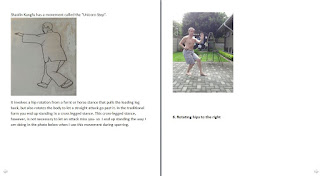A bit about Taijiquan- The Supreme Ultimate Fist
I learnt Jeet Kune Do as soon as I could. This is after all Bruce Lee's style that held the answer to all attacks and that could beat any style.
After having felt Ms Chen, my Taiji teacher's internal force I have decided to take up Taijiquan in order to see how this kind of force is developed.
In Kungfu this type of internal force is not exclusive to Tai Chi, but for some unexplained reason it got associated more with Tai Chi than with Shaolin.
Tai Chi is usually more the choice of those alternative thinking souls who want to experience inner peace and tranquility, so very few know that it was actually meant to be a fighting art and even fewer know how to use it as such.
https://youtu.be/Ed9-xZKymhc
So- the purpose of this post is to tell you some things about Tai Chi that you might not have heard yet.
1. The name does not have "Chi" in it:
I know Mr Fink in our group knows this, but as a youngster I had ideas of channeling waves or bolts of life energy through my limbs if I ever got to learn Tai Chi. I had to wait about 6 years from that time before I got to learn it. Taijiquan's name actually means- "The Supreme Ultimate Fist". This name might sound really boastful, but fits the stories regarding its development and accomplishments.
2. Taijiquan prioritises destruction of the enemy rather than defense:
I think a lot of Tai Chi students might choke on their chai tea when they hear this, but the fact is that Taijiquan's fighting applications are mainly offensive.
Sure- all martial arts have defensive moves and Taijiquan is no exception. It actually has some of the coolest responses to attacks. It is after all said to have been developed as a response to Shaolin's hard techniques.
A Taiji punch, however, is no joke. In fact- while Japanese karate has this principle of "Ikken Hissatsu" (death with one punch) incidents have been documented of Taiji exponents collapsing assailants with a single front kick. I have been practicing those punches and kicks against bags for years and from what I have experienced I do not want to see that type of kick in any tournament.
3. Taijiquan is not slow:
I know- if you see someone in a park doing the Cannon Fist form of Chen Taijiquan you would think it is another style of Kungfu altogether. Fact is, however, Taijiquan was initially developed to incapacitate assailants. No one can do that while moving slowly now, can they? The slow forms you see most of the time is known as the "Silk Reeling" Form. The purpose of this type of form is to gather and energy and channel it through the body and to build internal strength.
This form has become very popular with doctors and frail people who need to partake in light exercise. A large number of people go through their entire lives knowing only the slow form. I suspect that a large number of teachers know only the slow form as well.
4. Taijiquan has very effective footwork:
The thing is- for Taiji techniques to work the feet need to be flat on the ground to firmly root the body. This means that you will not see a Taiji exponent bouncing on the balls of his feet like modern martial artists. The one legged approach and rapid shifting of weight in many techniques however enable the Taiji exponent to evade attacks and close gaps as well as any other martial artist out there.
What I like about Taiji's attacks in this regard is that you can attack strongly and not lose your balance if you miss.
5. There is not only one style of Taijiquan:
Having so many styles of Kungfu in China makes it difficult to fathom that these styles can also vary into different styles themselves. The whole story of Taijiquan having been invented by Taoist immortal Chan San Feng starts becoming difficult to believe when you research a style's origin and find no link to this Immortal.
From what I can see the Chen style is the most wide spread. The Chinese State Commission for Physical Culture and Sports, however developed the 48 Step Form that was derived from more than one style and this form got taught in schools and public parks throughout China. A large number of Chinese who have gone to High School during the 1960's have gotten exposed to it.
Taijiquan is graceful as it is powerful. I love it and still do it every Sunday morning along with Qigong.
If you want to see some really good Taijiquan instructional videos- subscribe to Iain Sinclair's channel on Youtube. He is awesome!







"for Taiji techniques to work the feet need to be flat on the ground to firmly root the body"
ReplyDeleteAnd yet isn't one of the biggest "sins" in Taijichuan to be "double-weighted?"